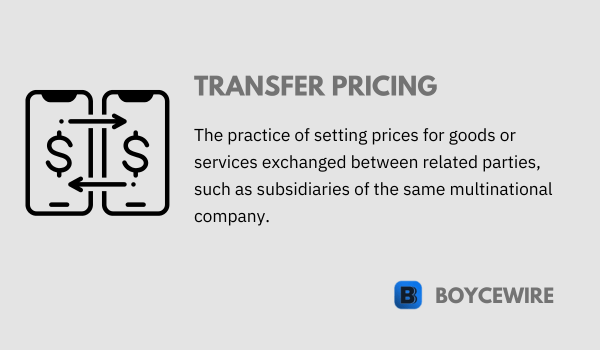Transfer Pricing: Definition, Methods & Examples

What is Transfer Pricing?
Transfer pricing refers to the pricing of goods, services, and intangible assets exchanged between related entities within a multinational enterprise. In today’s increasingly globalized business environment, it plays a critical role in international commerce, as it affects the allocation of profits among different jurisdictions and can have significant tax implications. This article provides an overview of the concept of transfer pricing, its objectives, methods, regulations, risks, and best practices.
Key Points
- Transfer pricing is the practice of setting prices for goods or services transferred between related parties, such as subsidiaries of the same multinational company.
- The goal of transfer pricing is to determine a fair and reasonable price for the transaction that reflects the value of the goods or services being transferred.
- Transfer pricing can have significant tax implications for companies and governments. If prices are set artificially low, profits can be shifted to low-tax jurisdictions, leading to lower tax revenue for the countries where the profits were actually earned.
- To ensure compliance with regulations, companies must keep detailed records of all related-party transactions and pricing decisions, conduct regular audits, and seek advice from tax professionals.
Understanding Transfer Pricing
Transfer pricing arises when two or more related entities within a multinational corporation engage in transactions with each other, such as the sale of goods, provision of services, or the transfer of intangible assets like intellectual property. These transactions need to be priced to determine the amount of profit each entity earns and the taxes they owe in their respective jurisdictions.
Objectives
The primary objective of transfer pricing is to allocate profits fairly among related entities within a multinational enterprise, considering the functions performed, risks assumed, and assets employed by each party. Proper practices also ensure compliance with tax laws and regulations in different countries, minimize the risk of double taxation, and optimize the overall tax burden of the group.
Influencing Factors
Several factors can influence transfer pricing decisions, including the nature of the goods or services being transferred, the functions and risks of each entity involved, the availability of comparable transactions between unrelated parties, and the applicable tax laws and regulations in each jurisdiction. Companies must carefully consider these factors when setting transfer prices to meet their strategic objectives and comply with legal requirements.
Transfer Pricing Methods
1. Traditional Transaction Methods
Comparable Uncontrolled Price (CUP) Method
The CUP method compares the price charged for goods, services, or intangibles transferred between related parties with the price charged for similar transactions between unrelated parties. If there are reliable comparables, the CUP method provides the most accurate arm’s length price.
Resale Price Method
The resale price method is used when a product is purchased from a related party and resold to an unrelated party. The resale price is reduced by the appropriate gross margin, which represents the reseller’s profit for performing its functions and assuming its risks. The remaining amount is considered the arm’s length price of the original transaction between the related parties.
Cost-plus Method
The cost-plus method is applied when a related party provides goods or services to another related party. The provider’s costs of producing the goods or services are determined and marked up by an appropriate profit margin, which reflects the provider’s functions, risks, and assets. The resulting price is considered the arm’s length price of the transaction.
2. Transactional Profit Methods
Transactional Net Margin Method (TNMM)
The TNMM compares the net profit margin of a related party transaction to the net profit margins earned by comparable independent enterprises in similar transactions. The method is generally applied to the least complex entity involved in the transaction and is suitable when reliable comparables data is available for net profit margins.
Profit Split Method
The profit split method is used when related parties contribute unique and valuable assets or perform highly integrated functions. The combined profits from the transaction are split based on the relative value of each party’s contribution, considering functions performed, risks assumed, and assets employed. This method is appropriate when both parties make significant contributions to the transaction and other methods cannot reliably determine arm’s length pricing.
Selecting a Transfer Pricing Method
Companies must choose the most appropriate transfer pricing method based on the specific facts and circumstances of their transactions. This may involve a thorough functional analysis, the identification of reliable comparables, and the evaluation of the strengths and weaknesses of each method.
The chosen method should provide the most reliable measure of the arm’s length price, considering the available data and the specific features of the transaction.
Transfer Pricing Examples
Transfer pricing refers to the process of setting prices for goods and services exchanged between different divisions or subsidiaries within the same company. It is a common practice among multinational corporations that operate in various countries with different tax rates and regulations. Some examples can be seen below:
- Manufacturing and Distribution: A multinational corporation manufactures electronic goods in a country with low production costs and then sells these goods to its distribution subsidiary in a country with high consumer demand. The manufacturing subsidiary charges the distribution subsidiary a transfer price for the goods, which influences the profits of both subsidiaries and the overall tax burden of the corporation.
- Intellectual Property Licensing: A company with valuable intellectual property, such as patents or trademarks, can establish a subsidiary in a low-tax jurisdiction to hold these intangible assets. The subsidiary then licenses the intellectual property to other subsidiaries within the company at a specified transfer price. This arrangement can reduce the overall tax burden of the corporation by shifting profits to the low-tax jurisdiction.
- Provision of Management Services: A multinational corporation might have a centralized management team that provides various services to its global subsidiaries, such as strategic planning, marketing, and human resources management. The company charges its subsidiaries a transfer price for these services, which can influence the subsidiaries’ profits and the overall tax liability of the corporation.
- Financing Arrangements: A company can establish a financing subsidiary in a low-tax jurisdiction to provide loans to other subsidiaries within the corporation. The financing subsidiary charges interest on these loans at a specified transfer price, which can affect the profits of both the lending and borrowing subsidiaries and the overall tax burden of the corporation.
In each of these examples, transfer pricing plays a crucial role in determining the allocation of profits within a multinational corporation, which can have significant implications for the company’s tax liability and regulatory compliance.
Transfer Pricing Regulations and Guidelines
1. The Role of the OECD
The OECD provides guidance on transfer pricing through its Transfer Pricing Guidelines for Multinational Enterprises and Tax Administrations. These guidelines are widely followed by tax authorities and multinational corporations around the world, and they establish the arm’s length principle as the international standard for transfer pricing.
2. Country-specific Regulations
Most countries have their own transfer pricing rules and regulations, which are generally consistent with the OECD Guidelines. These rules may include specific documentation requirements, reporting obligations, and penalties for non-compliance. Companies conducting related party transactions across international borders must be aware of and comply with the transfer pricing rules in each jurisdiction in which they operate.
3. Advance Pricing Agreements (APAs)
Advance pricing agreements (APAs) are agreements between taxpayers and tax authorities that establish an approved transfer pricing methodology for a specific set of transactions over a specified period. APAs can provide certainty for taxpayers and tax authorities, reduce the risk of double taxation, and minimize the likelihood of transfer pricing disputes. APAs can be unilateral, involving one taxpayer and one tax authority, or multilateral, involving multiple taxpayers or tax authorities.
4. Dispute Resolution Mechanisms
Transfer pricing disputes between taxpayers and tax authorities can be resolved through various dispute resolution mechanisms, such as negotiation, mediation, arbitration, or litigation. In addition, the OECD’s Mutual Agreement Procedure (MAP) provides a framework for resolving international transfer pricing disputes between tax authorities, with the goal of avoiding double taxation for the taxpayer.
Transfer Pricing Risks and Challenges
1. Risk of Double Taxation
Double taxation occurs when two or more countries tax the same income, leading to excessive tax burdens for multinational corporations. Transfer pricing adjustments can result in double taxation when tax authorities in different countries have differing views on the arm’s length price of a transaction. This may lead to significant financial and reputational risks for companies.
2. Audits and Disputes
Tax authorities around the world are increasingly focused on transfer pricing, resulting in a higher risk of audits and disputes. Companies must be prepared to defend their transfer pricing policies and documentation in the event of an audit, which can be time-consuming and costly. Disputes can also lead to penalties and interest charges, further increasing the financial risk for companies.
3. Compliance with Regulations
Transfer pricing regulations are complex and can vary significantly between jurisdictions. As countries continue to update and refine their transfer pricing rules, multinational corporations must stay informed of the latest developments and ensure compliance with the changing regulatory landscape. Failure to comply with these regulations can result in significant financial penalties and reputational damage.
Strategies and Best Practices
Developing a Robust Policy
To minimize risks, companies should develop a comprehensive policy that aligns with their overall business strategy and objectives. This policy should clearly articulate the company’s transfer pricing methodologies, functional and risk analysis, and arm’s length pricing principles, ensuring consistency across all related party transactions.
Implementing Consistent Documentation
Companies should maintain thorough and consistent documentation that supports their transfer pricing policies and complies with local and international regulations. This documentation should include a master file, local files, and country-by-country reports, as well as any additional documentation required by specific jurisdictions.
Regular Monitoring
Regular monitoring and benchmarking of transfer pricing policies and practices can help companies identify potential risks and areas for improvement. By analyzing comparable transactions, companies can ensure their methodologies remain in line with market conditions and arm’s length principles, reducing the risk of adjustments and disputes.
Transfer Pricing Compliance
Country-by-Country Reporting (CbCR)
Country-by-Country Reporting (CbCR) is a key component of the OECD’s Base Erosion and Profit Shifting (BEPS) initiative, which aims to improve transparency and combat tax avoidance by multinational corporations. Under CbCR, large multinational corporations must report detailed financial and tax information for each jurisdiction in which they operate, allowing tax authorities to assess potential risks more effectively.
Local and Master File Requirements
In addition to CbCR, multinational corporations must also prepare and maintain documentation in the form of a master file and local files. The master file provides an overview of the company’s global operations and transfer pricing policies, while local files provide detailed information on specific intercompany transactions and the methodology applied in each jurisdiction.
Staying informed and proactive
To ensure compliance with regulations, companies should stay informed of the latest developments in rules and requirements in each jurisdiction where they operate. This includes monitoring changes in legislation, attending relevant seminars and conferences, and engaging with tax professionals and advisors. By taking a proactive approach to compliance, companies can reduce the risk of audits, disputes, and penalties.
Conclusion
Transfer pricing is a critical aspect of international taxation for multinational corporations, with significant risks and challenges arising from complex regulations, audits, and potential disputes.
By developing robust policies, maintaining consistent documentation, and staying informed of the latest regulatory developments, companies can mitigate these risks and ensure compliance with rules across all jurisdictions in which they operate.
Through proactive management, multinational corporations can not only avoid financial penalties and reputational damage but also optimize their global tax strategies and contribute to a more transparent and equitable international tax environment.
FAQs
Transfer pricing refers to the practice of setting the price for goods or services sold between related parties, such as subsidiaries of the same multinational company.
Transfer pricing is important because it can have significant tax implications for companies and governments. If transfer prices are set artificially low, profits can be shifted to low-tax jurisdictions, leading to lower tax revenue for the countries where the profits were actually earned.
The most commonly used methods of transfer pricing are the comparable uncontrolled price (CUP) method, the resale price method, the cost plus method, and the transactional net margin method (TNMM).
Transfer pricing is regulated by tax authorities in each country. The Organisation for Economic Co-operation and Development (OECD) also provides guidelines for best practices.
About Paul
Paul Boyce is an economics editor with over 10 years experience in the industry. Currently working as a consultant within the financial services sector, Paul is the CEO and chief editor of BoyceWire. He has written publications for FEE, the Mises Institute, and many others.

Further Reading
 Monopolistic Competition: Characteristics & Examples - A market that has Monopolistic structure can be seen as a mixture between a monopoly and perfect competition. Whilst monopoly…
Monopolistic Competition: Characteristics & Examples - A market that has Monopolistic structure can be seen as a mixture between a monopoly and perfect competition. Whilst monopoly…  Examples of Socialism in America - In America, examples of socialism include the New Deal programs, progressive taxation and social welfare policies, public education and healthcare…
Examples of Socialism in America - In America, examples of socialism include the New Deal programs, progressive taxation and social welfare policies, public education and healthcare…  Mergers and Acquisitions: Definition, Pros, Cons & Examples - Mergers and acquisitions refer to the joining of two companies to form one entity.
Mergers and Acquisitions: Definition, Pros, Cons & Examples - Mergers and acquisitions refer to the joining of two companies to form one entity. 